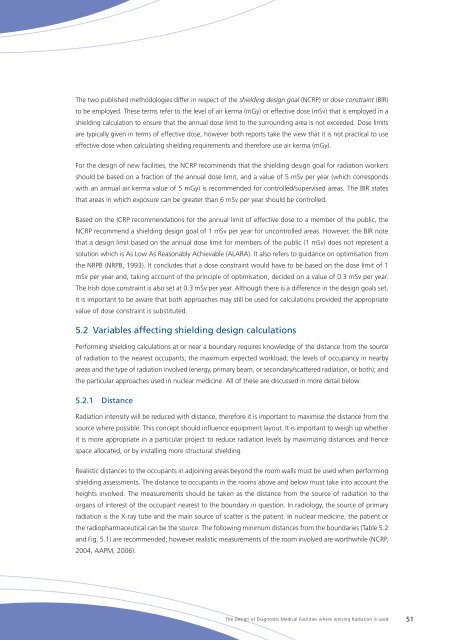The Design of Diagnostic Medical Facilities where ... - ResearchGate
The Design of Diagnostic Medical Facilities where ... - ResearchGate
The Design of Diagnostic Medical Facilities where ... - ResearchGate
You also want an ePaper? Increase the reach of your titles
YUMPU automatically turns print PDFs into web optimized ePapers that Google loves.
<strong>The</strong> two published methodologies differ in respect <strong>of</strong> the shielding design goal (NCRP) or dose constraint (BIR)<br />
to be employed. <strong>The</strong>se terms refer to the level <strong>of</strong> air kerma (mGy) or effective dose (mSv) that is employed in a<br />
shielding calculation to ensure that the annual dose limit to the surrounding area is not exceeded. Dose limits<br />
are typically given in terms <strong>of</strong> effective dose, however both reports take the view that it is not practical to use<br />
effective dose when calculating shielding requirements and therefore use air kerma (mGy).<br />
For the design <strong>of</strong> new facilities, the NCRP recommends that the shielding design goal for radiation workers<br />
should be based on a fraction <strong>of</strong> the annual dose limit, and a value <strong>of</strong> 5 mSv per year (which corresponds<br />
with an annual air kerma value <strong>of</strong> 5 mGy) is recommended for controlled/supervised areas. <strong>The</strong> BIR states<br />
that areas in which exposure can be greater than 6 mSv per year should be controlled.<br />
Based on the ICRP recommendations for the annual limit <strong>of</strong> effective dose to a member <strong>of</strong> the public, the<br />
NCRP recommend a shielding design goal <strong>of</strong> 1 mSv per year for uncontrolled areas. However, the BIR note<br />
that a design limit based on the annual dose limit for members <strong>of</strong> the public (1 mSv) does not represent a<br />
solution which is As Low As Reasonably Achievable (ALARA). It also refers to guidance on optimisation from<br />
the NRPB (NRPB, 1993). It concludes that a dose constraint would have to be based on the dose limit <strong>of</strong> 1<br />
mSv per year and, taking account <strong>of</strong> the principle <strong>of</strong> optimisation, decided on a value <strong>of</strong> 0.3 mSv per year.<br />
<strong>The</strong> Irish dose constraint is also set at 0.3 mSv per year. Although there is a difference in the design goals set,<br />
it is important to be aware that both approaches may still be used for calculations provided the appropriate<br />
value <strong>of</strong> dose constraint is substituted.<br />
5.2 Variables affecting shielding design calculations<br />
Performing shielding calculations at or near a boundary requires knowledge <strong>of</strong> the distance from the source<br />
<strong>of</strong> radiation to the nearest occupants; the maximum expected workload; the levels <strong>of</strong> occupancy in nearby<br />
areas and the type <strong>of</strong> radiation involved (energy, primary beam, or secondary/scattered radiation, or both); and<br />
the particular approaches used in nuclear medicine. All <strong>of</strong> these are discussed in more detail below.<br />
5.2.1 Distance<br />
Radiation intensity will be reduced with distance, therefore it is important to maximise the distance from the<br />
source <strong>where</strong> possible. This concept should influence equipment layout. It is important to weigh up whether<br />
it is more appropriate in a particular project to reduce radiation levels by maximizing distances and hence<br />
space allocated, or by installing more structural shielding.<br />
Realistic distances to the occupants in adjoining areas beyond the room walls must be used when performing<br />
shielding assessments. <strong>The</strong> distance to occupants in the rooms above and below must take into account the<br />
heights involved. <strong>The</strong> measurements should be taken as the distance from the source <strong>of</strong> radiation to the<br />
organs <strong>of</strong> interest <strong>of</strong> the occupant nearest to the boundary in question. In radiology, the source <strong>of</strong> primary<br />
radiation is the X‐ray tube and the main source <strong>of</strong> scatter is the patient. In nuclear medicine, the patient or<br />
the radiopharmaceutical can be the source. <strong>The</strong> following minimum distances from the boundaries (Table 5.2<br />
and Fig. 5.1) are recommended; however realistic measurements <strong>of</strong> the room involved are worthwhile (NCRP,<br />
2004, AAPM, 2006).<br />
<strong>The</strong> <strong>Design</strong> <strong>of</strong> <strong>Diagnostic</strong> <strong>Medical</strong> <strong>Facilities</strong> <strong>where</strong> Ionising Radiation is used 51
















